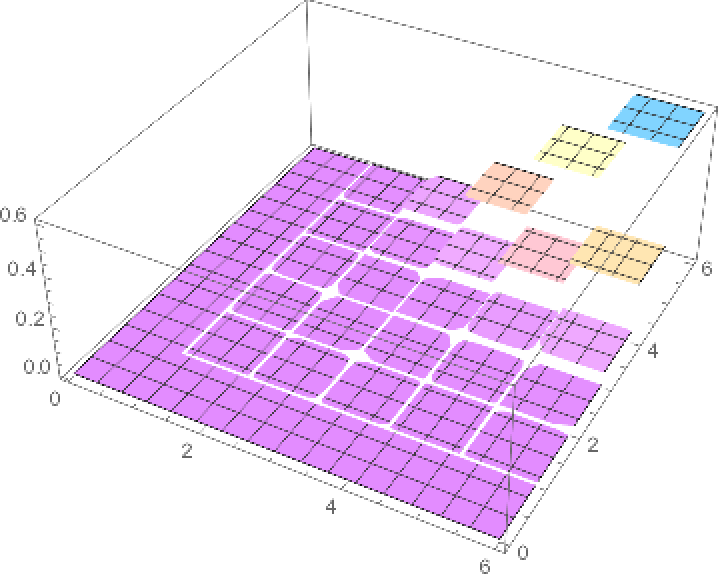Wolfram Function Repository
Instant-use add-on functions for the Wolfram Language
Function Repository Resource:
Transform a statistical distribution by applying the same function to all of its arguments
ResourceFunction["MappedTransformedDistribution"][f,dist] creates a transformed distribution for which the function f is mapped over all of the arguments. |
Compute the CDF of a product distribution of two binomial distributions in which 1 has been added to each of the arguments:
| In[1]:= | ![CDF[ResourceFunction["MappedTransformedDistribution"][# + 1 &, ProductDistribution[BinomialDistribution[2, 3/5], BinomialDistribution[2, 4/5]]], {x, y}]](https://www.wolframcloud.com/obj/resourcesystem/images/c8a/c8a8ef3b-1a4b-4012-bc90-5e2b65e37f4c/5f5baa43f1d98fe6.png) |
| Out[1]= |  |
Compute the CDF of a lognormal distribution in which the argument has been negated:
| In[2]:= |
| Out[2]= |
Compute the SurvivalFunction of a binomial distribution in which the square root is applied to its argument:
| In[3]:= |
| Out[3]= |
Compute the mean of a mapped transformed distribution of a multivariate discrete distribution:
| In[4]:= | ![Mean[ResourceFunction["MappedTransformedDistribution"][# + 1 &, ProductDistribution[BinomialDistribution[2, 3/5], BinomialDistribution[2, 4/5]]]]](https://www.wolframcloud.com/obj/resourcesystem/images/c8a/c8a8ef3b-1a4b-4012-bc90-5e2b65e37f4c/6d16b37ae72cd52e.png) |
| Out[4]= |
Compute the characteristic function of a mapped transformed distribution of a multivariate symbolic continuous distribution:
| In[5]:= | ![CharacteristicFunction[
ResourceFunction["MappedTransformedDistribution"][Sqrt, ProductDistribution[BetaDistribution[a, b], BetaDistribution[c, d]]], {t1, t2}] // TraditionalForm](https://www.wolframcloud.com/obj/resourcesystem/images/c8a/c8a8ef3b-1a4b-4012-bc90-5e2b65e37f4c/7232d088b7cfb3d9.png) |
| Out[5]= |  |
Compute the mean of a mapped transformed distribution of a copula distribution of two binomial distributions:
| In[6]:= | ![Mean[ResourceFunction["MappedTransformedDistribution"][1/(1 + #)^r &, CopulaDistribution[{"Binormal", -3/10}, {BinomialDistribution[10, 1/5], BinomialDistribution[10, 2/7]}]]]](https://www.wolframcloud.com/obj/resourcesystem/images/c8a/c8a8ef3b-1a4b-4012-bc90-5e2b65e37f4c/6aee34f09a4fc8ac.png) |
| Out[6]= |  |
Plot the CDF of a copula distribution whose components are binomial and each argument of which has been transformed by adding 1 to it:
| In[7]:= | ![Plot3D[Evaluate[
CDF[ResourceFunction["MappedTransformedDistribution"][# + 1 &, CopulaDistribution[{"Binormal", -0.3}, {BinomialDistribution[5, 3/5], BinomialDistribution[5, 4/5]}]], {x, y}]], {x, 0, 6}, {y,
0, 6}, PlotRange -> All, ColorFunction -> "Pastel"]](https://www.wolframcloud.com/obj/resourcesystem/images/c8a/c8a8ef3b-1a4b-4012-bc90-5e2b65e37f4c/473b60cb580cc763.png) |
| Out[7]= |  |
If the function mapped over the arguments to a continuous distribution is negation, that is, -#&, the roles of CDF and SurvivalFunction are effectively exchanged:
| In[8]:= |
| Out[8]= |
The SurvivalFunction of a discrete distribution evaluated at x is the same as the CDF of the mapped transform distribution evaluated at -(x+1), where the mapped function is -#& and the distribution is defined over integers:
| In[9]:= |
| Out[9]= |
Compute the probability that a person alive at age 61 will be dead before age 71 given that their mortality is determined by a discretized variant of a Gompertz–Makeham mortality function:
| In[10]:= | ![discreteGompertzMakehamDistribution[a_, b_] := ProbabilityDistribution[{"PDF", CDF[GompertzMakehamDistribution[a, b], t + 1] - CDF[GompertzMakehamDistribution[a, b], t]}, {t, 0, 120, 1}]](https://www.wolframcloud.com/obj/resourcesystem/images/c8a/c8a8ef3b-1a4b-4012-bc90-5e2b65e37f4c/11b38f1d6bc9e867.png) |
| In[11]:= | ![(* Evaluate this cell to get the example input *) CloudGet["https://www.wolframcloud.com/obj/7fb29df8-8f08-4783-aca8-8c373a8eec13"]](https://www.wolframcloud.com/obj/resourcesystem/images/c8a/c8a8ef3b-1a4b-4012-bc90-5e2b65e37f4c/75086cd5a134c4cc.png) |
| Out[11]= |
This work is licensed under a Creative Commons Attribution 4.0 International License